Ask the Pros: Split shots
Page 1: David Doubilet, Franco Banfi, Cristian Dimitrius, Allison Vitsky Sallmon and Andy Sallmon.
Page 2: Matt Smith, Douglas Seifert.
Page 3: Mike Veitch, David Fleetham, Eiko Jones.
Page 4: Viktor Lyagushkin, David Salvatori, Becky Kagan Schott.
Page 5: Rico Besserdich, Julian Cohen, Berkley White.

David Doubilet
David Doubilet have been taking pictures underwater for 5 decades. He is a contributing photographer for National Geographic Magazine where he has published nearly 70 stories since his first assignment in 1971. David was named a National Geographic Contributing Photographer-in-Residence in 2001. He is honored to be a Rolex Ambassador and recipient of the prestigious Explorers Club Lowell Thomas Award and Lennart Nilsson Award for Scientific Photography.
David’s personal challenge is to create a visual voice for the world’s oceans and to connect people to the incredible beauty and silent devastation happening within the invisible world below.
What is your favorite lens for shooting over/under images? Please specify whether you are shooting full frame or cropped sensor. What size dome port do you use?
My go-to equipment for half and images:
Nikkor 14-24 mm f2.8 zoom
Nikkor 16 mm f 2.8 fisheye
Nikon D4 and D3S
SEACAM Housing
SEACAM Superdome
Sea & Sea YS 250 Strobes
How do you expose the images? Do you use tools in post to adjust either underwater or above water exposures?
These pictures must be made at f16 or f22 for depth of field to hold up.
The theory: Underwater the lens focuses on a virtual image 18 inches in front of the dome. Overwater the lens focuses on infinity making depth of field a critical element in the image.
The approach: I build the image around f22, the “unmovable” f-stop. For example a bright tropical sunny day in clear water I would dial in f22 @ 1/160th at 200 ISO. Light the bottom of the image with 2 Sea & Sea YS 250 strobes at half or full power. A third strobe maybe used on a long cord.
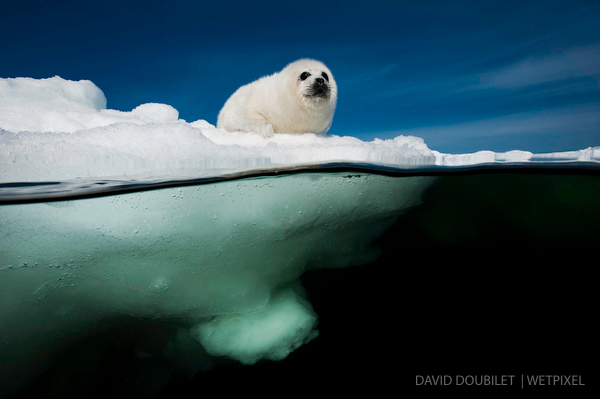
Get the exposure right in the camera and you will have a stronger, truthful image.
How do you shoot splits of fast moving animals?
The suite of Nikons I use can shoot up to 11+ fps. My strobes can keep up with this at ¼ to ½ power. I try and anticipate the action and make the camera earn a living.
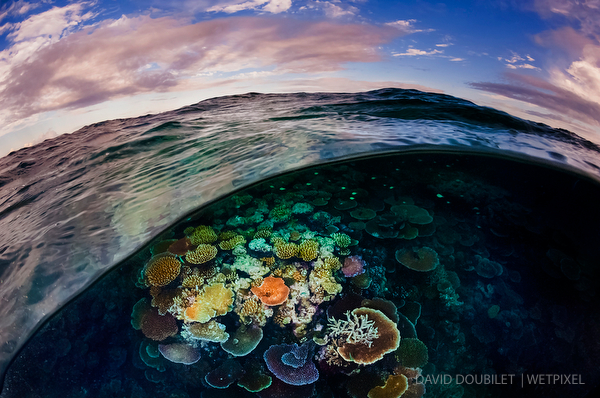
What makes for a great dive site for shooting over/unders? (Shallow reefs, sun angles etc.)
Great half-and-half images must have drama above and below. I find working in waist-deep shallow water produces powerful scenes. An infinite underwater horizon such as coral reef or sun dappled sand disappearing into the blue works well.
In deep water I take off my BC and inflate it to use as a raft for my camera. I try not to shoot into backlight because it produces to many artifacts and internal lens reflections. And lets talk about the evil water droplets. Yes, there are a dozen recipes out there to reduce water droplets. I use the dunking method. Dunk & shoot, dunk & shoot.
There are 3 elements to a good half-and-half:
1) The surface must be compelling. Get out there and look for it.
2) The underwater half of the image drives the image. It needs to be uncluttered and dynamic. Color is always a bonus.
3) The surface itself needs to include dramatic elements such as reflections or a wave breaking across the big dome creating a crystalline effect. The surface is a thin molecular curtain that can create optical magic.
Why do you think over/unders are so popular with people? Do your split level shots sell well? In turn, do you set out to shoot them specifically for this?
The power of the half-and-half image: These images bring the two elements of our planet together. They are especially striking when viewed by people that have never been diving and enjoyed the experience of viewing our treasured ecosystems underwater.
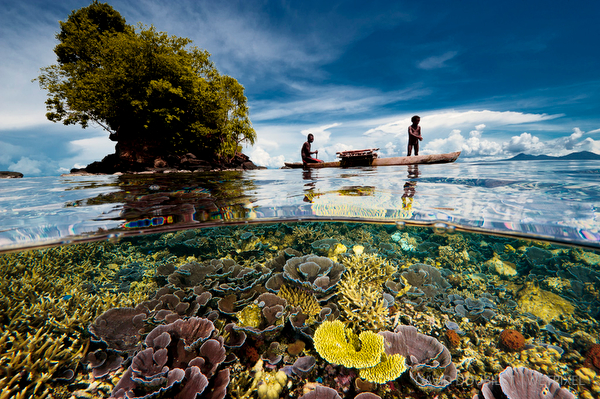
It is grounding for the viewer to see the surface, a familiar concept, juxtaposed with the underwater realm. The half and half image is an invitation to go below and to learn about a world hidden from most people’s view. As a photojournalist I find that a half-and-half picture can anchor a story by giving it is a sense of place while bringing underwater subjects to life.
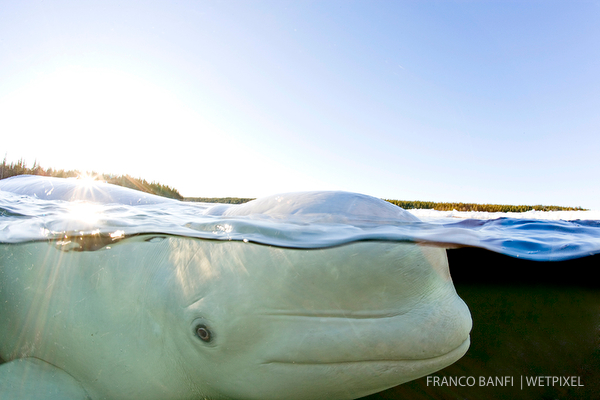
Franco Banfi
Franco Banfi is a professional wildlife photographer and photo-journalist, well known for his expertise and accuracy in underwater imaging. Recently he specialized in leading photo expeditions and in giving workshops and seminars about photography in different locations.
What is your favorite lens for shooting over/under images? Please specify whether you are shooting full frame or cropped sensor. What size dome port do you use?
I use a Canon 5D MKIII full frame with EF15mm f/2.8 Fisheye, for split image I like to use the super dome, better to balance and to keep the right level.

How do you expose the images? Do you use tools in post to adjust either underwater or above water exposures?
I expose the image closing the f-stop at least to f/16, before there was a problem because you would get a slow shutter speed, today with the new digital camera you can keep a decent shutter speed increasing the ISO.
I try to realize the shot in the camera but of course sometime is difficult to get the right exposure over and under, in this case Photoshop can help and I adjust in Camera Raw with the neutral density graduated filter.
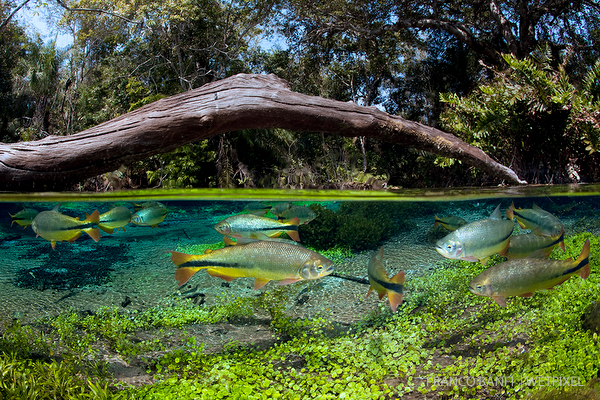
How do you shoot splits of fast moving animals?
Not easy!!! I don’t remember to have shot a fast moving animals split, but I guess that if you are shooting a fast moving animal split, the topside it’s no more so important. In this case the setting of the camera can change and you will open the f/stop according to your light and strobe, eventually I would synchronize on the second curtains.

What makes for a great dive site for shooting over/unders? (Shallow reefs, sun angles etc.)
Shallow reef are for sure more easy, each place where you can position yourself without big effort is good, but the most important for me is the top side. If there is nothing over the surface, why I have to do a split shot!
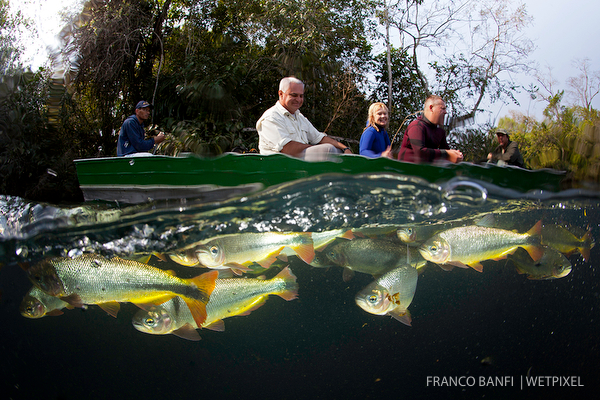
Why do you think over/unders are so popular with people? Do your split level shots sell well? In turn, do you set out to shoot them specifically for this?
Because it’s a good way to show people what is underwater and topside on the same image and people like it. It makes also a very good effect to non diver. I don’t know if they sell well but for sure the editor like them. Usually I try to think in advance when I want to make it but sometime you see the situation and you try anyway also without the right equipment and setting.
Cristian Dimitrius
Cristian Dimitrius is a Brazilian Emmy Award Winning cinematographer, photographer, biologist and television presenter specializing in wildlife and natural history films around the world.
What is your favorite lens for shooting over/under images? Please specify whether you are shooting full frame or cropped sensor. What size dome port do you use?
What a coincidence, I write this from an assignment in the Amazon where I have been using some splits shots in video to tell the flooded forest story. I love split shots and for doing them I use the 16-35mm canon for video in both 5dmkIII (full frame) and red dragon (35mm).
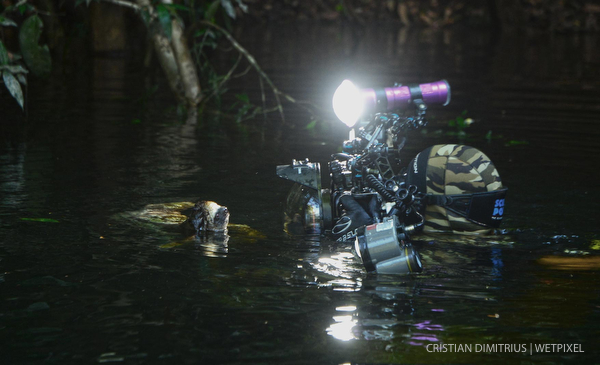
I have the 8-15mm that I use in very dark waters, like shooting pink river dolphins in the Amazon, but the distortion can be a problem in the video and you need to check if your client will accept it. I recently used the new 11-24 Canon, the widest rectilinear lens available, and I liked the results very much. I tested it in a river in Florida and the images where pretty sharp, no distortions and great for connecting both worlds, forest and river. My guess is that this lens will be one of the favorites for many shooters. For all my split shots I use a 9in dome, my Zen ZP-230.
How do you expose the images? Do you use tools in post to adjust either underwater or above water exposures?
When possible I use lights underwater to balance the environment, or strobes if I am doing stills. When shooting using natural light, I try not to overexpose the top side to save the bottom side so I don’t lose information. In post I use graduated filter on the top and adjust the shadows in the bottom.
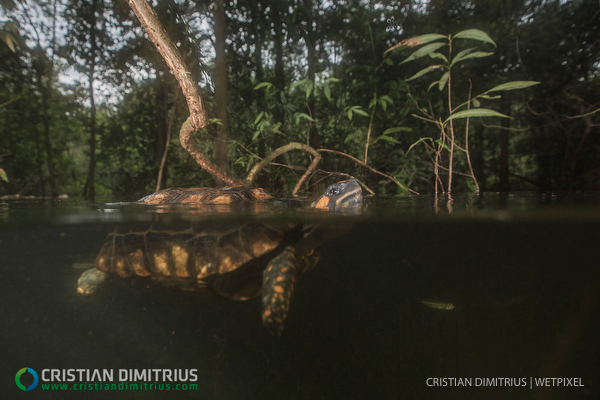
With video it is harder because we cant get it far from the sweet spot so I pay lots of attention to the dark and clipping pixels. Like I said, I in the Amazon doing these shots where I had to film a endemic possum surviving in the flooded forest. The river was pretty dark so I had to add a fill up light to balance the exposures and use the sun on my back to maximise the ambient light available. Usually back light shots in this environment are harder so I have even use a light on the top of the camera to avoid silhouetting the subject. In shallow waters, specially clear waters like those of the Bahamas, there is no stress and you can just use your favorite exposure method for the whole scene.
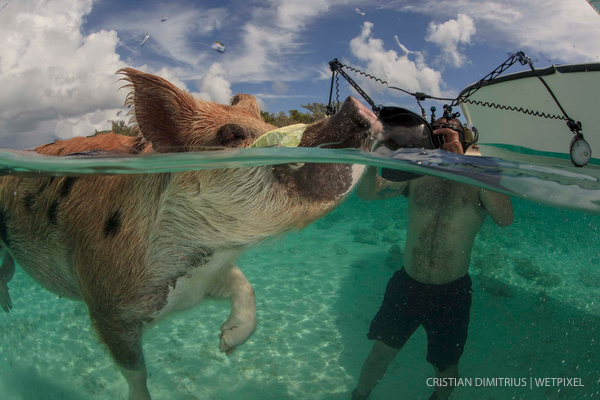
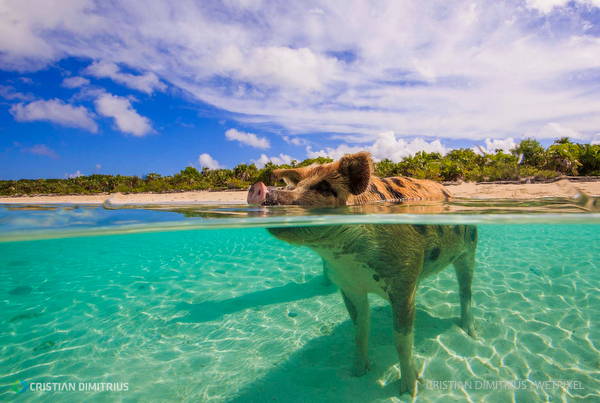
How do you shoot splits of fast moving animals?
I haven’t done this often, but I have shot sharks, birds, dolphins and even a swimming sloth, that can be much faster in water than in trees.
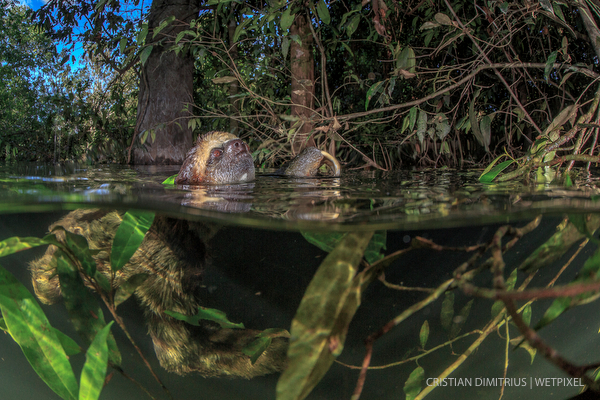
I usually try it after doing the planned, and hence safer, shots and mostly for stills because in video it can be a little confusing (unless this is the idea). When I go for fast shots I don’t expect the usual rectilinear line between the two sides of the picture. I like a more confused separation that add movement to the image. I believe this effect can cause a much nicer impression than a rectilinear line.
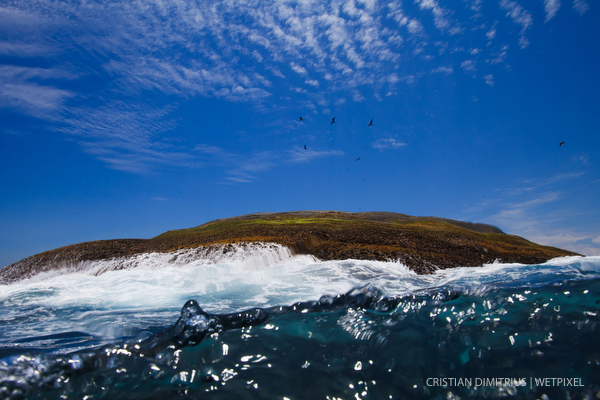
So if you want to do that, you just need to think fast, set the camera right and hit the shutter. It works better with a faster camera, but you still need some luck to get a great shot. I have also done splits while waiting for a rescue after a dive when shooting for a book in a remote island. I was there floating, had nothing better to do, saw the opportunity, so I started to play with it. I had not planned this at all but in the end I got some good shots. In this case it worked very well for me as I was able to include it into a book where it gave me the opportunity to illustrate the environment of the remote island with many pictures. So after you have done all the basic shots, push the limits and try some splits! In the end you can always find a good use for them.
What makes for a great dive site for shooting over/unders? (Shallow reefs, sun angles etc.)
You can use your creativity in any site since there are always relevant subjects both over and under the surface line. I prefer shallow reefs and even rivers, specially when you have a clear connection between both environments, like a sloth swimming in a flooded forest or an American Crocodile living in the mangroves of Cuba. In this case you need this kind of shot to tell a story.
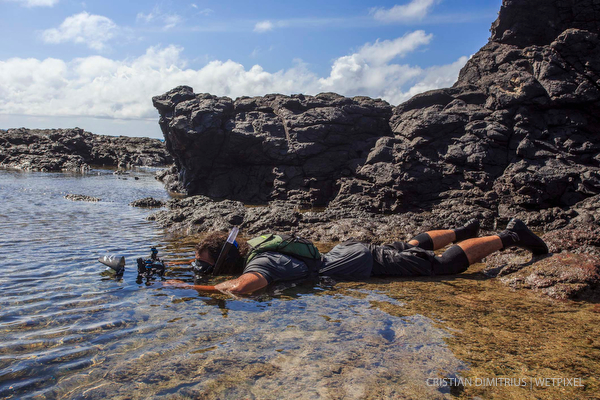
One consideration we need to take care are drops in the dry part of the dome. I don’t usually go just for spit shots so my field resource is usually saliva, spitting in the dome like to avoid fogging the mask and rubbing it. It might work for one or two shots. Other chemical solutions like baby shampoo are usually very good too. Sometimes occasional drops don’t ruin the picture. in some cases they are part of the shot and in others you can remove with a spot removal tool.
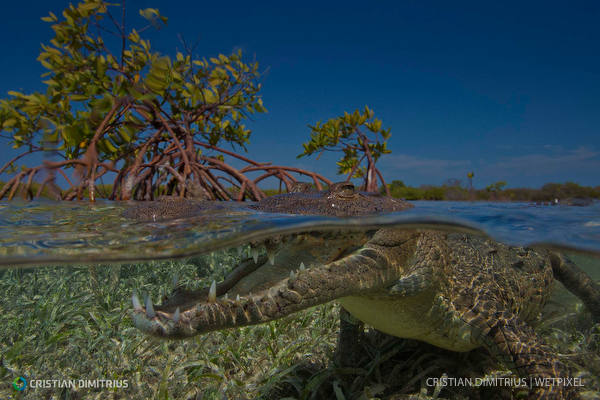
For me is more important to get the shot: Just go for it if you haven’t planned ahead!
Why do you think over/unders are so popular with people? Do your split level shots sell well? In turn, do you set out to shoot them specifically for this?
I believe they are so popular because they connect the two worlds and you can definitely tell a good story with one single picture. It is not just about a great artistic and technically precise shot. Here you need a good story, like the one below that I sold to a wildlife magazine in Brazil.
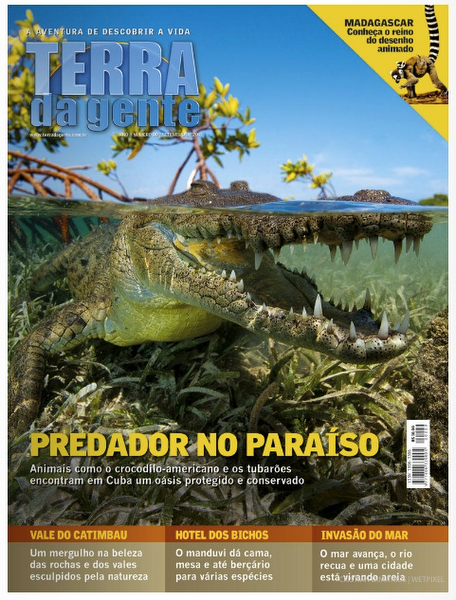
The image shows the connection between the american crocodile and its home, the mangrove. The only way to tell this story in one picture was to do a split shot and in this case, it was sold immediately. In videos you can great the same connection, and people love to see it when well done, but video stories are told in a sequences, so you can connect the worlds with several images and a good script. In the still world a image can literally worth more than a thousand words and that is why split shots can be your best decision sometimes.
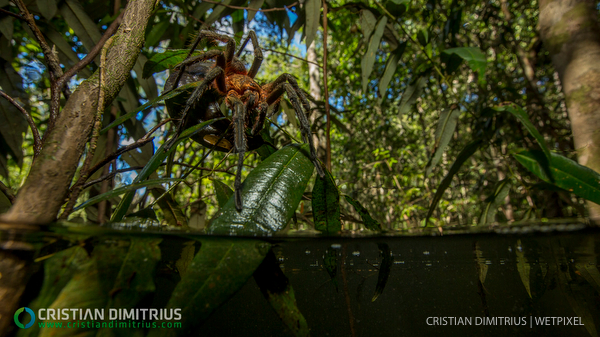
Allison Vitsky Sallmon and Andy Sallmon
Andy and Allison Sallmon are professional marine photographers based in San Diego, California.
What is your favorite lens for shooting over/under images? Please specify whether you are shooting full frame or cropped sensor. What size dome port do you use?
Canon 8-15 mm fisheyes on full-frame cameras, though we have also used rectilinear lenses. Since we are most often shooting over/unders incidentally either at the beginning or end of a dive, we’re mostly using 8 or 10-inch dome ports, though a larger dome would be more ideal for splits. Importantly, we use glass dome ports with antireflective coatings to prevent glare.
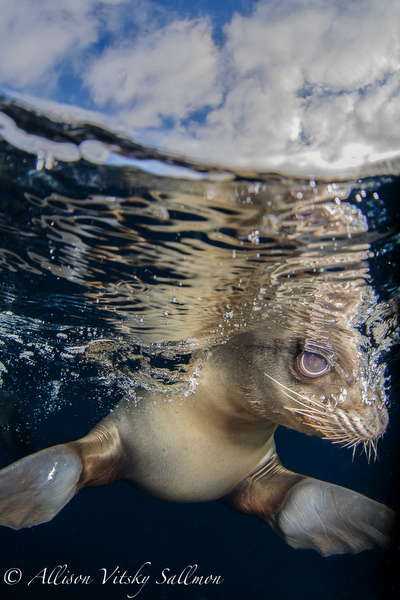
How do you expose the images? Do you use tools in post to adjust either underwater or above water exposures?
We find that in most scenarios, a fast shutter speed and as small an aperture as possible is best. We try to expose for underwater primarily, toning down the topside section in post if needed. There are some filters in Lightroom that are well suited for this purpose.
How do you shoot splits of fast moving animals?
I believe the appropriate phrase is “spray and pray…” We find it is best to prefocus the camera and start shooting early, a split before the subject is where we’d ultimately like it to be.

What makes for a great dive site for shooting over/unders? (Shallow reefs, sun angles etc.)
Shallow reefs or animals with interesting and topside sights – landscape, pretty sky, or a boat. For reefscapes, we prefer that over/unders say something definitive about location, either from a subject or topside perspective (or both).
Why do you think over/unders are so popular with people? Do your split level shots sell well? In turn, do you set out to shoot them specifically for this?
For divers, I think they remind us of the anticipation of a dive while we’re still at the surface…or maybe they remind us of surfacing in a gorgeous location. And for non-divers, I think they’re a relatable way to show them what we’re seeing just under the ocean’s surface. We do find that they sell fairly well (now that we’re considering the proportion of underwater to split images we shoot, they sell extraordinarily well…). While we don’t set out to do many over-under “shoots”, when conditions allow for them, we always try to take advantage!